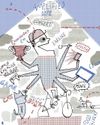CREATING THE OFFICE OF THE FUTURE
strategy+business
|Winter 2020
In a remodeled world, it is vital for companies to reinvent ways of working.

The corporate office is on the brink of a major renovation. The lockdowns that began in the U.S. in mid-March in response to the novel coronavirus created an extraordinary migration as employees across the country began working at home. People patched together ways to keep going when the lights went off in office buildings, and, for the most part, it has worked: In the June 2020 PwC US Remote Work Survey, three out of four employers called work from home (WFH) a success.
It’s no surprise, then, to find widespread interest in maintaining some form of WFH once the pandemic recedes. Everybody benefits. Employees avoid lengthy commutes and spend more time with their family. Employers have access to talent regardless of location, improve resiliency through a distributed workforce, and reduce expenses by optimizing their real estate footprint. Even the environment gets a break, thanks to fewer people commuting, reduced business travel, and less heating and cooling of office space. The Remote Work Survey shows that 73 percent of employees would like to work remotely at least two days a week, even once COVID-19 is no longer a concern. Similarly, 55 percent of executives are prepared to expand options for employees to work outside the office.
Bu hikaye strategy+business dergisinin Winter 2020 baskısından alınmıştır.
Binlerce özenle seçilmiş premium hikayeye ve 9.000'den fazla dergi ve gazeteye erişmek için Magzter GOLD'a abone olun.
Zaten abone misiniz? Oturum aç
strategy+business'den DAHA FAZLA HİKAYE

strategy+business
Transforming information into insight
Focus on six organizational elements to build a world-class data and insights capability.
8 mins
Winter 2020

strategy+business
THE URGENT NEED FOR SOPHISTICATED LEADERSHIP
The pandemic has highlighted a series of paradoxes inherent to the work of leaders. What comes next will depend on how well leaders face up to them.
14 mins
Winter 2020

strategy+business
The road to successful change is lined with trade-offs
Rather than trying to convince people your change initiative is the right one, invite them to talk openly about what it might take to implement it: the good, the bad, and the frustrating.
15 mins
Winter 2020

strategy+business
Sustaining productivity virtually
Maintaining productivity levels among remote employees is an enduring challenge. Here are five ways to help businesses and employees thrive while people work at home.
7 mins
Winter 2020

strategy+business
FORWARD TO normal
Entertainment and media companies are building business models that are resilient to the enduring changes in consumer behavior ushered in by COVID-19.
14 mins
Winter 2020

strategy+business
How leaders can promote racial justice in the workplace
Embrace four principles to turn today’s diversity, equity, and inclusion initiatives into sustained progress.
9 mins
Winter 2020

strategy+business
CREATING THE OFFICE OF THE FUTURE
In a remodeled world, it is vital for companies to reinvent ways of working.
11 mins
Winter 2020

strategy+business
Consumer companies must take leaps, not steps
As shoppers show how quickly they can adapt to external shocks, retailers will need to radically reconfigure their business models.
7 mins
Winter 2020

strategy+business
Businesses can fast-track innovation to help during a crisis
“Unrealistic” timelines can actually work. Here’s how.
5 mins
Winter 2020

strategy+business
Agility and experience management work better together
Many companies achieve early wins with separate transformational efforts, then stall. But if combined and enhanced using “return on experience,” or ROX, measures, these two programs can unlock each other’s potential.
7 mins
Winter 2020
Translate
Change font size

